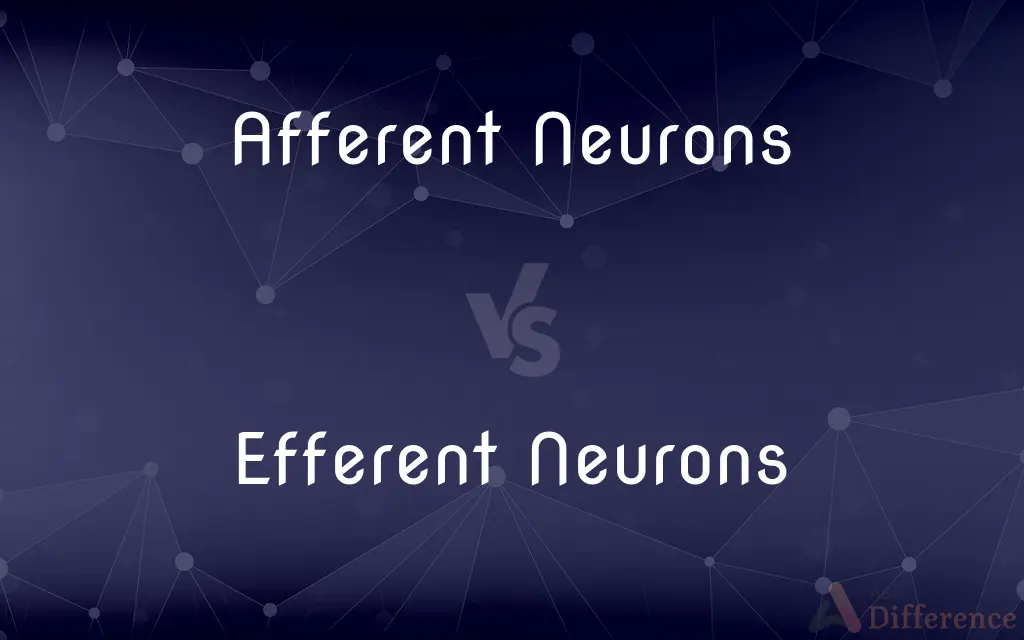Afferent Neurons vs. Efferent Neurons — What's the Difference?
By Tayyaba Rehman — Published on December 4, 2023
Afferent Neurons convey signals from sensory receptors to the CNS, while Efferent Neurons transmit signals from the CNS to effector organs.

Difference Between Afferent Neurons and Efferent Neurons
Table of Contents
ADVERTISEMENT
Key Differences
Afferent Neurons are specialized nerve cells responsible for sending sensory information from the body's external environment and internal organs to the central nervous system (CNS). Their primary function is to inform the CNS about what's happening outside and inside the body. Efferent Neurons, on the other hand, play a crucial role in transmitting motor commands from the CNS to the body's muscles and glands, allowing for responses to sensory information.
While Afferent Neurons carry signals toward the brain and spinal cord, Efferent Neurons carry them away. It's a communication system where Afferent Neurons keep the CNS informed, and Efferent Neurons enable the CNS to act upon that information. This dynamic duo ensures the body can sense its environment and react appropriately.
The directionality of the signal is a key difference. Afferent Neurons receive information from sensory receptors like the skin or eyes and relay it to the CNS. Efferent Neurons, conversely, receive commands from the CNS and deliver them to the effector organs to produce an action, like muscle contraction.
In essence, Afferent Neurons and Efferent Neurons are part of the body's feedback loop. Afferent Neurons inform the CNS about sensory stimuli, allowing it to process and interpret. Efferent Neurons then take action based on this processed information, ensuring the body responds adequately to its environment.
Comparison Chart
Direction of Signal
Towards the CNS.
Away from the CNS.
ADVERTISEMENT
Function
Sensory transmission.
Motor transmission.
Receives Information From
Sensory receptors.
Central nervous system.
Sends Information To
Central nervous system.
Muscles, glands, or other effector organs.
Response Type
Reactive to external/internal stimuli.
Initiates actions or responses.
Compare with Definitions
Afferent Neurons
Communicators of sensory information.
The touch of a feather triggered Afferent Neurons in the skin.
Efferent Neurons
Facilitators of bodily responses.
Efferent Neurons activated salivary glands during hunger.
Afferent Neurons
Carriers of signals towards the brain.
When the foot stepped on a tack, Afferent Neurons sent the pain signal upward.
Efferent Neurons
Link between the CNS and effector organs.
Efferent Neurons directed the hand to pull away from the flame.
Afferent Neurons
Informants of internal and external changes.
Afferent Neurons signaled the change in blood pressure.
Efferent Neurons
Executors of CNS's processed information.
Upon sensing danger, Efferent Neurons spurred the legs into action.
Afferent Neurons
Nerve cells sending signals to the CNS.
Afferent Neurons relayed the sensation of the hot stove to the brain.
Efferent Neurons
Conductors of motor commands.
Efferent Neurons conveyed the brain's command to blink.
Afferent Neurons
Bridge between sensory receptors and CNS.
Afferent Neurons ensured the brain was aware of the cold breeze.
Efferent Neurons
Nerve cells transmitting commands from the CNS.
Efferent Neurons signaled the muscles to contract.
Common Curiosities
Which neurons detect pain or touch?
Afferent Neurons detect sensory stimuli like pain or touch and send this information to the CNS.
What are Afferent Neurons?
Afferent Neurons are nerve cells that send sensory information from the body to the central nervous system.
What role do Efferent Neurons play in movement?
Efferent Neurons convey commands from the CNS to muscles, facilitating movement.
Are Afferent Neurons also called sensory neurons?
Yes, Afferent Neurons are often referred to as sensory neurons.
How do Afferent Neurons contribute to reflex actions?
Afferent Neurons detect stimuli, like pain, and send this info to the CNS, which may trigger a reflex action via Efferent Neurons.
How do Efferent Neurons function?
Efferent Neurons transmit commands from the central nervous system to muscles, glands, or other effector organs.
Are Efferent Neurons also termed motor neurons?
Yes, Efferent Neurons are often termed motor neurons.
Are Afferent and Efferent Neurons found throughout the body?
Yes, both Afferent and Efferent Neurons are distributed throughout the body, facilitating sensation and response.
Do Efferent Neurons play a role in emotion?
Indirectly, as emotions can trigger Efferent Neurons to produce physical responses, like a racing heart.
Can Efferent Neurons influence gland secretion?
Yes, Efferent Neurons can transmit signals to glands, influencing their secretion.
Which neuron type primarily interacts with muscles?
Efferent Neurons primarily interact with muscles, directing them to contract or relax.
How are Afferent Neurons involved in taste?
Afferent Neurons relay sensory information from taste receptors to the CNS.
What happens when Efferent Neurons malfunction?
Malfunctioning Efferent Neurons can result in motor issues or improper gland function.
How does the body sense temperature changes?
Afferent Neurons detect temperature changes and relay this information to the CNS.
Share Your Discovery

Previous Comparison
Preparative Centrifugation vs. Analytical Centrifugation
Next Comparison
Intracellular Fluid vs. Extracellular FluidAuthor Spotlight
Written by
Tayyaba RehmanTayyaba Rehman is a distinguished writer, currently serving as a primary contributor to askdifference.com. As a researcher in semantics and etymology, Tayyaba's passion for the complexity of languages and their distinctions has found a perfect home on the platform. Tayyaba delves into the intricacies of language, distinguishing between commonly confused words and phrases, thereby providing clarity for readers worldwide.
















































